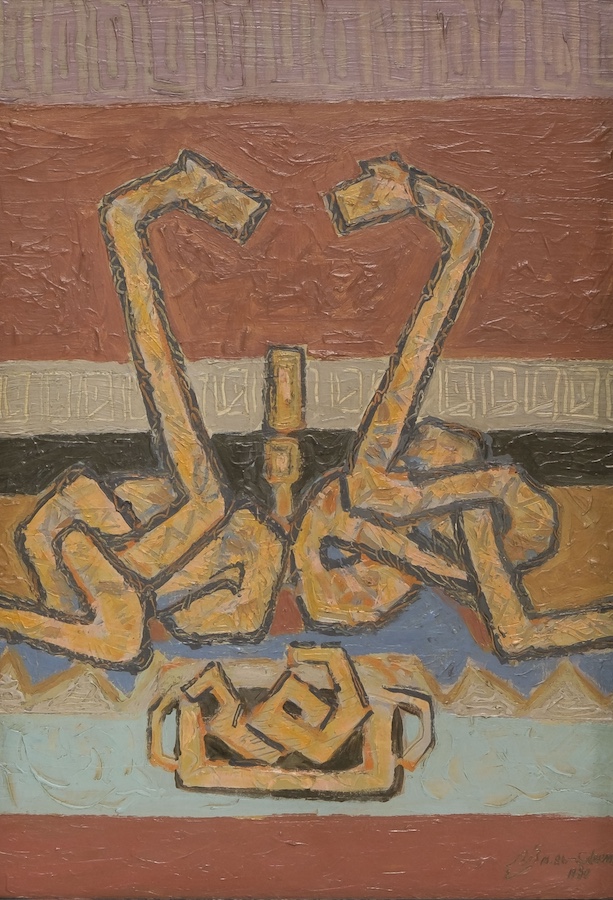DUBAI: The late Mohammed Al-Saleem was once again the Kingdom’s stand-out performer at art auctions this year, topping the price list for a single work by a Saudi artist at both Christie’s and Sotheby’s.
He didn’t quite match the record-breaking levels of the 1986 piece sold by Sotheby’s last year, which made him the first Saudi artist in history to fetch more than $1 million for an auctioned work, but this year Al-Saleem’s 1990 work “Bi nur al-iman, nara al-s'adah” (In the light of faith, we see happiness) realized well over twice its highest estimated price for Christie’s, eventually selling for £630,000 (around $788,285), while, at Sotheby’s, an untitled Al-Saleem piece from 1960 went for £84,000.
Seen together, the two pieces clearly demonstrate Al-Saleem’s evolution as an artist over the three decades separating the pieces. But the earlier piece also shows just how well-defined Al-Saleem’s aesthetic sense was even at the start of his artistic journey.

Mohammed Al Saleem, 'Untitled,' 1960. (Supplied)
As Sotheby’s head of sale for 20th Century Art/Middle East, Alexandra Roy, says of the untitled painting, “It’s a work that’s finding its own language. And they you see him really evolve, which I think is always a sign of a great artist — they really find their own language that you can recognize immediately. Even if you only know his later works, you can immediately infer that this was done by Mohammed Al-Saleem.
“You can see he is starting to think a lot about the visual culture around him,” she continues. “And what I love is that he is super-interested in the landscape around him, abstract art, calligraphy, the Qu’ran… and this work combines a bit of all of that: it has the abstract, the calligraphy, and that important element of the landscape around him with the figures in the painting, which are actually camels.
“It’s actually super-rare to find a work from the 1960s and really amazing to see the development — how he goes on from this,” she continues. “There’s something traditional and yet very avant-garde about this work. For me, it looks like an Arab flag. So, immediately, my associations go to those early pan-Arab artistic movements. It’s also very textured — he’s really creating something with depth and movement. And visually it has all of these elements which kind of harken back to the Islamic world, to Saudi Arabia’s landscape, to popular motifs, but done in a very original way.”

Mohammed Al-Saleem. (Supplied)
Ridah Moumni, Christie’s chairman, Middle East and Africa, also stresses the fact that Al-Saleem had a very clear aesthetic identity — one which, by the time he came to paint “Bi nur al-iman, nara al-s'adah” — had become clearly defined.
“It’s more than the technique. It’s really the composition,” Moumni says. “He creates very abstract layers of colors, in which we see a sort of geometry that we can sometimes identify as human forms, or calligraphy, or animal forms. It’s very interesting. Sometimes people would say this is a Saudi style — I don’t think it is; it’s the style of Mohammed Al-Saleem. He’s an excellent painter in the way he uses the colors to create these abstractions.”
This particular work is unusual in the way that Al-Saleem used a painted frame to divide the canvas into quarters.
“This is a really special work. You won’t see two of them. It’s a rare composition and I think the collectors who saw this work saw its exceptional quality,” says Moumni. “I find this piece extremely beautiful. I love it because it’s an abstract piece, with spectacular composition, but it’s also a piece that is absolutely optimistic and shows extraordinary creativity. In the Nineties, the artist was really struggling financially. Then he paints this beautiful message — ‘In the light of faith, we see happiness.’
“I think the Arab world is full of talent, of resilience, of creativity, of richness. And I think the artists of the Arab world have so much to give, not only regionally, but also from a global perspective,” he continues. “So when I see this work, I see also the optimism and the generosity of the art scenes of the region. The Arab world has so much to give, and we have so much to learn from its artists.”
























